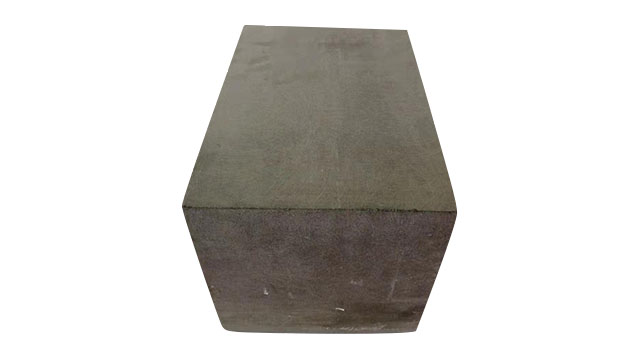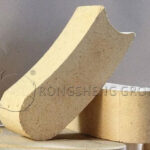The fused refractory is made by melting the precisely prepared mixture in an electric arc furnace, then pouring it into a sand mold, and the ingot is heat-treated before machining. The smelting process can obtain complete coarse crystals and dense structures. Compared with sintered refractories, it has the characteristics of compact structure, low porosity, high bulk density, high mechanical strength and high-temperature structural strength, and strong resistance to glass liquid erosion. Fused corundum bricks for glass-melting furnaces. The main varieties currently produced are fused mullite bricks, fused zirconium corundum bricks, fused chromium zirconium corundum bricks, fused quartz bricks, fused corundum bricks, etc.

Fused Mullite Brick
Mullite brick is an aluminum-silicon system refractory product with mullite as the main crystal phase. The refractory temperature is around 1850℃, the load softening temperature is high, the high-temperature creep rate is low, and the thermal shock resistance is good.
Fused mullite bricks use high alumina bauxite as raw material, and mix different bauxite into mullite composition (3Al2O3 2SiO2, the mass fractions are: Al2O3 72%, SiO2 28%). It is melted at around 2300°C, cast in a sand mold at 1850°C, and then annealed to relieve stress. The main crystal phases are mullite and corundum, and the glass phase is filled between the crystal phases. Its resistance to glass erosion is stronger than that of sintered refractories but not as good as other fused refractories. Adding a small amount of 7%~8.5% zirconium dioxide can make the mullite crystal smaller, the brick structure denser, and the mullite content increase to 60%~70%. The content of the glass phase is relatively reduced, and the cracks of the product are reduced. Fused mullite bricks have been basically replaced by fused zirconium bricks.
Fused Zirconium Corundum Brick
Fused zirconium corundum brick belongs to the Al2O3-ZrO2-SiO2 system (AZS brick for short). The content of ZrO2 is divided into three grades, and the corresponding grades are AZS-33 (containing ZrO2 33%), AZS~36 (containing ZrO2 36%), and AZS-41 (containing ZrO2 41%).
Fused zirconium corundum bricks are made of zircon and industrial alumina as the main raw materials, and then add a small amount of zircon-rich sand (in order to increase the content of ZrO2), soda ash, and borax. According to the different atmospheres during melting, there are two kinds of reduction melting methods and oxidative melting methods. At present, the oxidation method is mainly used. The oxidation melting method can remove the pollution caused by the graphite electrode in the molten liquid, and the carbon content is low (0.005%~0.02%), which can reduce the bubble content in the glass and improve the quality of the glass liquid.
Precautions when using fused zirconium corundum bricks
- ①Irregular changes in thermal expansion. Fused zirconium corundum bricks are characterized by stable and dense organization and strong resistance to glass liquid erosion. The thermal expansion curve of the brick containing 31%, and 33% ZrO2 has abnormal expansion between 900 and 1200 °C.
- Electrical insulation. Fused zirconium corundum bricks have good electrical insulation and decrease with increased temperature. Fused zirconium corundum bricks can be used for electrode bricks in the production of soda lime glass melting furnaces.
- Thermal conductivity. The thermal conductivity of fused zirconium corundum brick is twice that of clay brick. Therefore, when making pool wall bricks, the cooling air volume required near the liquid level should be twice as large as when clay bricks are used as pool walls.

Fused Corundum Brick
Fused corundum brick is made of high-purity alumina as raw material, and a small amount of soda ash is introduced, and it is melted at 2000-2200 ℃. The production process is similar to that of high-aluminum products. There are fused α-corundum bricks, fused α, β-corundum bricks, fused β-corundum bricks, etc. Fused α-corundum brick is mainly suitable for melting borosilicate glass, opal glass, and molten bodies containing sulfate. The composition of fused α, β-corundum bricks only contains a small amount of glass phase, which will not ooze out during use and has less pollution to the glass liquid. Direct contact with the molten glass will not cause the molten glass to be colored and has good corrosion resistance. The fused corundum brick is suitable for the upper structure of the working pool of the melting furnace and the combustion port at the rear of the melting zone and its surrounding breast walls, small furnace flats, and other parts.
Fused Chrome Zirconium Corundum Brick
10%~30% Cr2O3 is introduced into AZS-33 bricks, and fused chromium zirconium corundum bricks (abbreviated as AZCS bricks, French grade ER2161) are produced by the non-shrinkage casting method. The exterior and interior of the bricks are dark green. The brick contains a 4.5% shrinkage cavity and no connected pores. The viscosity of the glass phase is increased due to the formation of an aluminum-chromium spinel solid solution. It greatly improves the corrosion resistance of molten glass, which is 3.4 times that of fused AZS-33 bricks and 2.6 times that of fused AZS-41 bricks.
Fused Quartz Brick
The production process of fused silica brick is the same as that of quartz glass. Using high-purity quartz sand (SiO2 content above 99.5%) as raw material, adding a small amount of Na20 as a mineralizer, melting in a graphite resistance furnace (17501800 ℃). After melting, the whole molten material is quickly taken out, rolled into bricks, cooled in air, and then machined. The thermal expansion coefficient is extremely small, and the thermal shock resistance is good. The boron-resistant glass liquid has strong corrosion resistance, but it is not resistant to the erosion of soda-lime-silica glass liquid.
Zircon Brick
The main component of zircon products is ZrO2·SiO2. Zircon is decomposed into ZrO2 and SiO2 when heated at 1680℃. Zircon product liquid glass has good corrosion resistance, aluminum zirconium silicon (AZS) cast bricks and fired bricks have good resistance to glass liquid erosion, and can be used for the pool wall and upper structure of glass melting furnaces.
Zircon bricks are refractory products fired with zircon as the main raw material. Zircon is the only compound in the ZrO2-SiO2 system, and its chemical formula is ZrSiO4. The theoretical chemical composition of zircon is ZrO2 67.2%, and SiO2 32.8%. Zircon bricks have excellent properties such as high-temperature resistance, good thermal vibration resistance, and glass erosion resistance.
To purchase fused corundum bricks for glass-melting furnaces, please contact us. We can not only provide high-quality corundum brick products but also offer you competitive prices.








